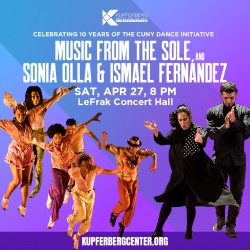Testimony to City Council Committee on Cultural Affairs, Libraries, and International Intergroup Relations Preliminary Budget Hearing
Monday, March 20, 2023
Testimony to City Council Committee on Cultural Affairs, Libraries, and International Intergroup Relations Preliminary Budget Hearing
Thank you for your consideration of this testimony, submitted on behalf of Dance/NYC, a service organization advancing the interest of the dance industry in the metropolitan NYC area through grantmaking, convening, and action-oriented research and advocacy. Dance/NYC reaches over 5,000 individual dance artists, 1,200 dance-making entities, 500 non-profit dance companies, and the many for-profit dance businesses based in the metropolitan New York City area. Our diverse constituents include Black, Indigenous, People of Color, immigrants, and disabled dance workers and dance organizations, businesses, projects, and groups.
Dance/NYC joins colleague advocates working across creative disciplines in thanking you for your leadership and calling on you to:
1. Ensure robust and equitable funding for arts and culture by:
• Adding $40 million as baseline funding to the Department of Cultural Affairs (DCLA) budget for FY 2024. The need to stabilize funding for arts and culture is urgent. It is destabilizing for the sector to have to fight for every penny every year, not knowing how much support will be forthcoming.
• Allocating an additional $10 million to the $40 million baseline to enable DCLA to fund the sector more equitably. Last year’s successes and failures of the Cultural Development Fund (CDF) grants process clearly demonstrated that we need more funding, not less.
2. Secure effective investment in arts education and ensure that all schools are able to provide arts instructions to all students by:
• Continuing and increasing funding to $6M for the “Support for Arts Instruction” initiative established this year by the City Council
• Restoring baseline funding of $24M for arts services cut at the onset of the pandemic
• Guaranteeing that the per capita funding intended for arts education is spent on arts education and that schools comply with state mandated arts learning standards
• Ensuring that all schools have at least one certified arts and dance teacher
Contributions of the arts and culture industry are at the core of New York City’s economic development and essential to its overall economic health. In addition to being the number one driver of tourism to the city, the arts and cultural sector generates $123.2 billion in economic activity and accounts for 13% of New York City’s total economic output.¹ In 2019, New York City’s arts, entertainment, and recreation sector employed 93,500 people in 6,250 establishments amounting to $7.4 billion in wages.² The dynamic economic activities of the creative industry have a multiplier effect that benefit adjacent industries, including real estate, business and professional services, wholesale and retail trade, eating and drinking establishments, hotels and personal services, utilities, transportation, medical and educational services, finance and insurance, generating an estimated $1.6 billion in additional revenues.³ Independent artists, writers and performers, performing arts companies, and promoters of performing arts are among the top five core industries within the arts and cultural sector. The dance industry contributes an estimated $300 million annually to the city’s economy, not including fiscally sponsored organizations, for profit enterprises, sole proprietorships, and individual dance workers.
In addition to its economic contribution, arts and culture are an integral part of a neighborhood cultural ecosystem that promote social well-being in the community.⁴ Studies have shown that the presence of cultural resources is significantly associated with improved outcomes in mental health, education, youth involvement in the criminal justice system, community safety, and other dimensions of well-being of a community.
The arts and culture sector has sustained and continues to incur some of the worst impact of the COVID-19 pandemic. A 2020 COVID-19 impact study by the Brookings Institution estimated that the creative industry in New York lost almost 280,000 jobs and $26.8 billion in revenues, the second highest rates in the country after California.⁵ In New York City, 95% of cultural organizations canceled programming, 88% modified the delivery of their programs, and 11% had to stop providing products or services to their communities resulting in accrued losses of over $6.8 billion.⁶ As of February 2022, total employment in the arts, entertainment, and recreation sector remains 18.8% below pre-pandemic levels.⁷
Dance/NYC’s own study finds that dance organization, group, and project budgets shrunk by 31%, with the smallest organizations and primarily BIPOC-led, losing an average of 52%. Our COVID impact research shows that 16% of dance workers left the city and 25 dance organizations have closed or shut down. The pandemic has had a disproportionate impact on small-budget groups and individual dance makers, which make up the majority of the dance-making sector but have historically lacked access to resources and support. Additionally, these impacts are felt most acutely by arts workers who identify as BIPOC, immigrants, and disabled among communities with less access to capital reserves.
Dance is consistently the least funded of all the performing arts, and dance workers face additional barriers to economic viability due to low levels of unionization in the field and a corresponding lack of wage standards and labor protections. Low wages within the sector can also be a deterrent for historically marginalized workers to remain employed sustainably in the field, particularly in small budget organizations that operate within their communities. Our current research suggests that dance workers maintain an average of 5 jobs to earn a living and less than half of them do not have access to retirement benefits and a significant number do not have access to healthcare. Thirty-six per cent (36%) of dance making organizations are in weak financial shape and 56% do not hold a reserve or any savings.
As New York City's primary agency dedicated to supporting arts and culture, the Department of Cultural Affairs (DCLA) plays a critical role in ensuring the sector not only survives but thrives. DCLA programs such as the Cultural Development Fund, Coalition of Theatres of Color Initiative, Cultural Immigrant Initiative, CASA and SU-CASA have served as lifelines for arts and cultural organizations and individual creative workers to sustain their work and deepen their engagement with communities. An investment of $40 million in baseline funding for DCLA would allow the agency’s provision of longer-term and more consistent support for cultural organizations. It is profoundly destabilizing for the sector to have to fight for every penny every year, not knowing how much support will be forthcoming. Unreliable funding support severely impacts our ability to hire needed personnel, to plan season performances, guarantee salaries for performers, among others.
In addition to the $40 million baseline funding, the city should allocate an additional $10 million to ensure that DCLA is able to fund the sector more equitably. The successes and failures of the FY 2023 Cultural Development Fund (CDF) program only made more evident the gap between the real need in the arts and cultural sector and the resources currently available in DCLA. While the CDF program created an opportunity for increased funding for some, including for many smaller organizations receiving their first grants, it also resulted in detrimental cuts to many others.
Arts education is a foundation for success in school and life and should be an essential part of every child’s education. Arts education not only improves academic performance of students, but also supports their social and emotional well-being, while fostering creativity and critical thinking. Dance therapy, in particular, is used to promote emotional, cognitive, and physical integration, and has been found to be especially beneficial for people with chronic diseases. Arts education is key to producing future generations of cultural leaders, artists, and passionate supporters with keen knowledge and appreciation of the arts. The City Council must continue to take bold steps in advancing arts education by increasing funding for the “Support for Arts Instruction” initiative that it established in FY 2023 to $6 million in FY 2024. The city should also guarantee that per capita funding for arts education is spent on arts education, and not depend solely on the discretion of school principals, which has resulted in hundreds of schools that are out of compliance with state-mandated arts learning requirements. Ensuring that all schools have at least one certified arts and dance teacher will go a long way towards achieving the long-term goal of all schools being able to provide arts instructions to all students.
Equity must be at the center of all budget allocations and funding programs across city agencies. The growth and resilience of the cultural sector has long been impeded by historic underinvestment by the city government and agencies in BIPOC, disabled people, and immigrant arts workers and organizations. This includes lack of access to funding at the governmental and philanthropic levels. DCLA must continue to address persistent systemic barriers that have long perpetuated these inequities and prioritize individual arts workers and small-budget cultural organizations serving these historically underinvested and underserved communities.
Dance/NYC calls on the city government to invest back its fair share in the arts and culture sector that more equitably reflects the industry’s role in the city’s economy and impact on the quality of life of New Yorkers.
##
¹ Office of the New York City Comptroller (2019). The Creative Economy: Art, Culture and Creativity in New York City. https://comptroller.nyc.gov/reports/the-creative-economy/
² Office of the New York State Comptroller (2021). Arts, Entertainment and Recreation in New York City Recent Trends and Impact of COVID-19. https://www.osc.state.ny.us/reports/osdc/arts-entertainment-and-recreation-new-york-city-recent-trends-and-impact-covid-19
³ Americans for the Arts. The Arts As an Industry: Their Economic Importance to the New York-New Jersey Metropolitan Region. https://www.americansforthearts.org/by-program/reports-and-data/legislation-policy/naappd/the-arts-as-an-industry-their-economic-importance-to-the-new-york-new-jersey-metropolitan-region-0
⁵ Florida, R. and Seman, Michael (2020). Lost Art: Measuring COVID-19’s devastating impact on America’s creative economy. Metropolitan Policy Program at Brookings. https://www.brookings.edu/wp-content/uploads/2020/08/20200810_Brookingsmetro_Covid19-and-creative-economy_Final.pdf
⁶ SMU Data Arts and the New York City Department of Cultural Affairs’ COVID-19 Impact on Nonprofit Arts and Culture in New York City (2020). https://culturaldata.org/pages/covid-19-impact-on-nonprofit-arts-and-culture-in-new-york-city/
⁷ Office of the New York City Comptroller. New York by the Numbers: Monthly Economic and Fiscal Outlook no. 64, April 4, 2022. https://comptroller.nyc.gov/newsroom/new-york-by-the-numbers-monthly-economic-and-fiscal-outlook-no-64-april-4th-2022/
⁸ Dance/NYC (2021). Coronavirus Dance Impact Study Informational Brief. https://www.dance.nyc/uploads/Covid-Impact-Study-Brief-210316.pdf




